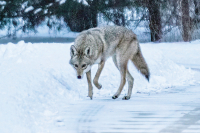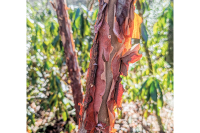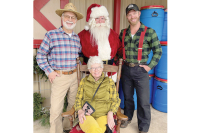Owls remain mysterious, alluring
Of late, I have been hearing the owls sounding off on the slopes and ridge lines behind our home. Some folks think of owls as evil omens, but I like to listen to them. They are, for me, the nocturnal call of the wild.
Learning to identify the owls that reside here in the Smokies region by sight or sound isn’t difficult. There are but five species one can reasonably anticipate encountering: barn, saw-whet, screech, great horned, and barred. Two others — the snowy and the long-eared have been reported from the mountains — but they are highly irregular winter visitors.
The barn owl, a white bird with a heart-shaped face that lends it a monkey-like appearance, is only occasionally encountered here. If you live on a large open farm with outbuildings that seem to be haunted by ghostly creatures emitting screams and chuckles, you probably have barn owls.
To see or hear the little eight-inch high saw-whet owl during the breeding season, you have to visit the spruce-fir country along the Blue Ridge Parkway or along the Clingmans Dome spur from Newfound Gap in the Smokies (especially at Indian Gap and the parking area of the Spruce-Fir Nature Trail), where they reach the southernmost extension of their range from the great Canadian zone forest. They can occasionally be observed in the lower elevations during the winter months.
In Birds of the Smokies (1991), East Tennessee State University ornithologist Fred Alsop noted: “The first report of this small northern owl’s occurrence in the park was made in 1941. Its presence has lured and excited many birders since .... The owl is named for the quality of its monotonous whistled song which, to the ornithologist who named it, sounded like someone sharpening (whetting) a saw.” The first nesting sites for this owl in the southern mountains were located for the first time in recent decades.
More common than the barn or saw-whet owls are the screech, great horned, and barred owls. In December when they are mating, I hear great horned owls hooting on the high ridges along the so-called “Road to Nowhere” that leads into the national park north of Bryson City. These great birds are the equivalent of a wildcat in regard to hunting prowess. They often live and feed in suburban or urban areas, where rodents are plentiful. If you have a cat that’s missing, think great horned owl.
Related Items
Screech owls are not aptly named, their call actually being a quavering, descending whinny. A better name would be “whinnying owl.” Alsop noted that: “They may be reddish, brown, or gray in their plumage and in the park the reddish phase outnumbers the gray by approximately four to one; brown plumaged birds are extremely rare.”
Learn to imitate their whistling call and they’ll answer you right back, especially from July into October. A mediocre imitator of owls, I have nevertheless lured them to within 15 or so yards or so of our back porch, probably hoping to see who the fool was making such a racket.
My favorite owl is the barred, which Alsop noted is “probably the the most frequently encountered owl in the Smokies.” If you spot a fair-sized owl, lacking “horns,” with a barred upper breast, it’s most likely a barred owl.
I sometimes hear them during daylight hours when walking backcountry trails, especially near gaps at about 3,500 to 4,000 feet. My notion (scientifically unverified) is that many bird species frequent gap areas so as to easily pass back and forth from one watershed or the other for sunlight or food.
I don’t ever recall walking up from Coopers Creek in the national park above Ela to Deeplow Gap on Thomas Divide Ridge without hearing a barred owl in the gap area. Up north, they are thought to say, “Who cooks for you? Who cooks for you?” While down south they seem to say, “Who cooks for you? Who cooks for you-all?” A native mountaineer might hear one calling out, “Who cooks for you? Who cooks for you-uns?” Same bird — differing regional dialects — depending on the ears of the beholder.
George Ellison wrote the biographical introductions for the reissues of two Appalachian classics: Horace Kephart’s Our Southern Highlanders and James Mooney’s History, Myths, and Sacred Formulas of the Cherokees. In June 2005, a selection of his Back Then columns was published by The History Press in Charleston as Mountain Passages: Natural and Cultural History of Western North Carolina and the Great Smoky Mountains. Readers can contact him at P.O. Box 1262, Bryson City, N.C., 28713, or at This email address is being protected from spambots. You need JavaScript enabled to view it..













